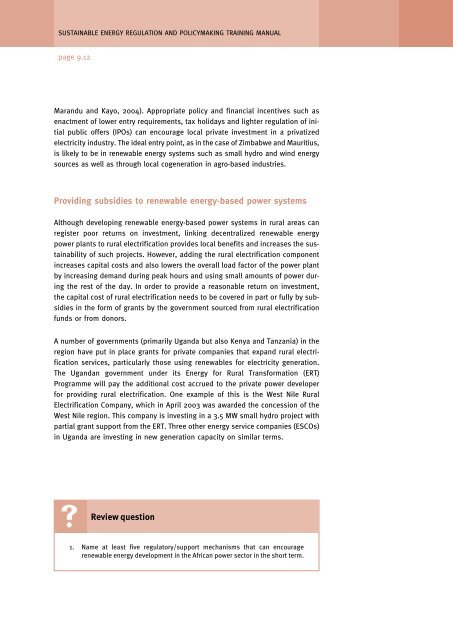Regulatory and policy options to encourage development of ...
Regulatory and policy options to encourage development of ...
Regulatory and policy options to encourage development of ...
- No tags were found...
Create successful ePaper yourself
Turn your PDF publications into a flip-book with our unique Google optimized e-Paper software.
SUSTAINABLE ENERGY REGULATION AND POLICYMAKING TRAINING MANUALpage 9.12Mar<strong>and</strong>u <strong>and</strong> Kayo, 2004). Appropriate <strong>policy</strong> <strong>and</strong> financial incentives such asenactment <strong>of</strong> lower entry requirements, tax holidays <strong>and</strong> lighter regulation <strong>of</strong> initialpublic <strong>of</strong>fers (IPOs) can <strong>encourage</strong> local private investment in a privatizedelectricity industry. The ideal entry point, as in the case <strong>of</strong> Zimbabwe <strong>and</strong> Mauritius,is likely <strong>to</strong> be in renewable energy systems such as small hydro <strong>and</strong> wind energysources as well as through local cogeneration in agro-based industries.Providing subsidies <strong>to</strong> renewable energy-based power systemsAlthough developing renewable energy-based power systems in rural areas canregister poor returns on investment, linking decentralized renewable energypower plants <strong>to</strong> rural electrification provides local benefits <strong>and</strong> increases the sustainability<strong>of</strong> such projects. However, adding the rural electrification componentincreases capital costs <strong>and</strong> also lowers the overall load fac<strong>to</strong>r <strong>of</strong> the power plantby increasing dem<strong>and</strong> during peak hours <strong>and</strong> using small amounts <strong>of</strong> power duringthe rest <strong>of</strong> the day. In order <strong>to</strong> provide a reasonable return on investment,the capital cost <strong>of</strong> rural electrification needs <strong>to</strong> be covered in part or fully by subsidiesin the form <strong>of</strong> grants by the government sourced from rural electrificationfunds or from donors.A number <strong>of</strong> governments (primarily Ug<strong>and</strong>a but also Kenya <strong>and</strong> Tanzania) in theregion have put in place grants for private companies that exp<strong>and</strong> rural electrificationservices, particularly those using renewables for electricity generation.The Ug<strong>and</strong>an government under its Energy for Rural Transformation (ERT)Programme will pay the additional cost accrued <strong>to</strong> the private power developerfor providing rural electrification. One example <strong>of</strong> this is the West Nile RuralElectrification Company, which in April 2003 was awarded the concession <strong>of</strong> theWest Nile region. This company is investing in a 3.5 MW small hydro project withpartial grant support from the ERT. Three other energy service companies (ESCOs)in Ug<strong>and</strong>a are investing in new generation capacity on similar terms.Review question1. Name at least five regula<strong>to</strong>ry/support mechanisms that can <strong>encourage</strong>renewable energy <strong>development</strong> in the African power sec<strong>to</strong>r in the short term.










